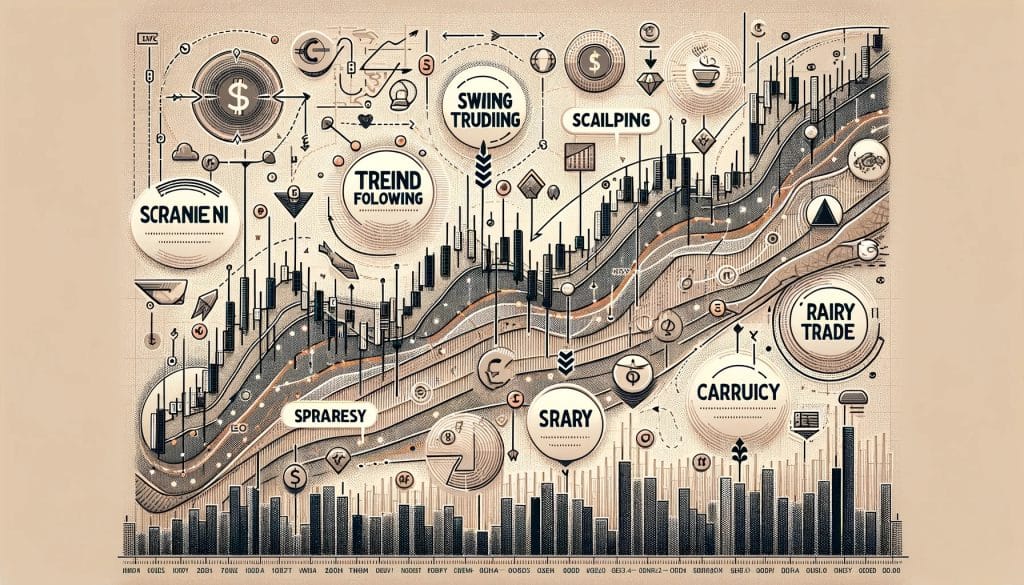Introduction to Forex Trading Strategies
The Forex market, a global arena for currency trading, presents unique opportunities for traders. Success in this volatile environment hinges on employing effective strategies. This guide delves into the top 5 Forex strategies, shedding light on the methods professional traders use to navigate market dynamics.

Top 5 Forex Strategies
Price Action Trading
Price action trading stands out for its reliance on past price movements to forecast future price behavior. This strategy eschews traditional indicators for a pure analysis of price charts. For example, a price action trader might use candlestick patterns to identify potential market reversals or continuation patterns.
Application of Price Action
A practical application involves scrutinizing a bullish engulfing pattern at a key support level, indicating a potential upward movement. Traders might enter a long position here, setting a stop loss just below the support level to mitigate risk.
Trend Following
Trend following strategies capitalize on the momentum of market trends. Traders identify the direction of the market trend and make trades that align with this direction. For example, using moving averages to determine a bullish trend, a trader may decide to buy a currency pair and hold the position as long as the trend persists, securing profits through trailing stops.
Effective Trend Following
An effective trend-following strategy might involve combining the 50-day and 200-day moving averages. A crossover of the 50-day moving average above the 200-day moving average signals a buy opportunity, suggesting a strong upward trend.
Scalping
Scalping is designed for traders who prefer quick, short-term trades. It involves making numerous trades within a day to profit from small price changes. For example, a scalper may focus on currency pairs with high liquidity during peak trading hours, using tight stop-loss orders to protect against significant losses.
Scalping in Action
A typical scalping session might involve using 1-minute or 5-minute charts to make trades that last just minutes, capitalizing on quick fluctuations in the EUR/USD currency pair.
Position Trading
Position trading is a long-term strategy where traders hold positions for weeks, months, or even longer, aiming to profit from major shifts in currency prices. This approach requires a profound understanding of fundamental factors that drive currency movements. For example, a position trader might buy a currency with strong economic fundamentals and hold it against a weaker currency, anticipating long-term appreciation.
Long-Term Position Trading Example
Consider a trader buying the NZD/JPY pair based on New Zealand’s strong economic outlook compared to Japan’s stagnation. The trader expects the NZD to appreciate over time, making this a strategic long-term investment.
Carry Trade
The carry trade strategy involves borrowing in a currency with a low-interest rate and investing in a currency offering a higher interest rate. Profits are made from the interest rate differential. For example, borrowing Japanese yen to buy Australian dollars can be profitable due to the interest rate gap between the two currencies.
Carry Trade Risks and Rewards
A successful carry trade example is borrowing in EUR (with low-interest rates) to invest in ZAR (with higher rates). However, traders must be wary of currency fluctuations that could offset the interest gains.

Implementing the Strategies
Implementing these strategies effectively requires a comprehensive understanding of market analysis, risk management, and the use of trading platforms. Traders should practice with demo accounts, stay informed about global economic indicators, and continually refine their approaches based on market feedback.
Risk Management in Forex Trading
Risk management is crucial, involving setting stop-loss orders, monitoring leverage, and diversifying investments. It’s the safeguard against unpredictable market movements and is integral to trading longevity.

Conclusion
The top 5 Forex strategies provide a foundation for success in the Forex market. By understanding and applying these methods thoughtfully, traders can enhance their trading performance, adapting to market changes with informed strategies. Remember, continuous learning and adaptation are key to navigating the Forex market effectively.
FAQs on Top 5 Forex Strategies
What is the best time frame for price action trading in Forex?
The best time frame for price action trading varies based on a trader’s style and objectives. Day traders often prefer shorter time frames like 1-hour or 15-minute charts, while swing traders may opt for 4-hour to daily charts for a broader view of market trends. Ultimately, the choice depends on how quickly the trader wants to enter and exit trades and their level of market analysis.
Can trend following strategies work in a sideways market?
Trend following strategies are most effective in markets with a clear direction (upward or downward). In a sideways or ranging market, these strategies might not perform as well since the lack of a strong trend can lead to false signals and potential losses. In such markets, traders might consider range-bound strategies, focusing on buying at support levels and selling at resistance levels.
How much capital do I need to start scalping in Forex?
The required capital to start scalping in Forex can vary significantly. Some brokers allow traders to open accounts with as little as $100, but effectively scalping, given the small profit margins per trade, generally requires a larger balance. Starting with at least $1,000 to $5,000 can provide a more reasonable foundation to absorb the costs of trading and the potential for multiple small losses.
Is position trading suitable for beginners?
Position trading can be suitable for beginners, especially those with a strong understanding of fundamental analysis and the patience to hold trades for extended periods. However, it requires a comprehensive grasp of global economic factors and the ability to withstand significant fluctuations in account equity. Beginners should start with a demo account to practice before committing significant capital.
What are the primary risks associated with the carry trade strategy?
The primary risks associated with the carry trade strategy include sudden shifts in interest rates, which can diminish the interest rate differential and thus the potential profit. Additionally, currency risk is a significant factor; if the currency being purchased depreciates against the currency being sold, it can lead to losses that may exceed the interest income. Political and economic events can also cause unexpected volatility, impacting the carry trade’s performance.
How do I choose the right Forex strategy for me?
Choosing the right Forex strategy involves assessing your risk tolerance, trading style, and the amount of time you can dedicate to trading. Beginners may start with more straightforward strategies, like trend following, to grasp market dynamics. Experimenting with different strategies on a demo account can also help determine which method aligns best with your goals and lifestyle.
Can I use multiple Forex strategies simultaneously?
Yes, many traders use multiple Forex strategies simultaneously to diversify their trading and capitalize on different market conditions. However, it’s crucial to thoroughly understand each strategy and be able to manage them without compromising decision-making or risk management. Starting with one strategy and gradually adding others as you gain confidence and experience is advisable.





